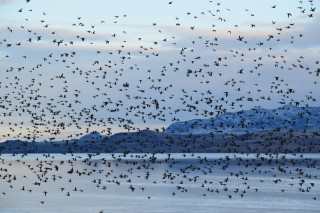Explorer Corps Marker: Davis County
Find the Marker
The Davis County marker is in the landscaped rock in front of the painted bison in the parking area on the south side of the Antelope Island Causeway tollbooth, on the way to Antelope Island.
GPS 41°5’20.1336”N 112°7’13.7316”W
Dig Deeper
Antelope Island is a world apart from the hustle and bustle of Salt Lake City. That might seem strange, given that the state park is only about an hour’s drive north from the urban center, but it’s true. One of several islands rising from the Great Salt Lake, Antelope Island is a wonderland for naturalists of all ages.

Technically speaking, there aren’t antelope on Antelope Island. The place got its name after John C. Fremont and Kit Carson followed a tip from Native Americans that there were pronghorn on the island. While commonly called antelope, as in “where the deer and the antelope play,” pronghorn are the last remaining species of a very different group of Ice Age mammals whose closest living relatives are giraffes. Drive or hike along the roads and trails snaking over the island and you’re likely to see these orange-and-white herbivores wandering around the island.
Pronghorn aren’t the only striking mammals to make Antelope Island their home. The island also hosts native species like badgers, bobcats, coyotes, and mule deer among its native species. The bison and bighorn sheep on the island, while native to western North America, were introduced during the 19th and 20th centuries.
But of all Antelope Island’s wild inhabitants, it’s the feathered friends that draw birdwatchers and visitors every year. That’s because the shores of Antelope Island are a critical stopover point for birds, which owes to the lavish invertebrate buffet the Great Salt Lake and its beaches provide.
The Great Salt Lake is – surprise – salty. Incredibly salty, in fact. The lake’s waters are about 12 times saltier than the oceans. Not very much can live in waters that salty. You won’t find any fish swimming through the Great Salt Lake, no amphibians croaking or crawling through the shallows along the lake margins. But invertebrates – with their exoskeletal casings – have been able to cope with the extremely salty waters. The beaches of Antelope Island host innumerable clouds of innumerable brine flies, and the waters of the lake are famously filled with brine shrimp.
For birds, the flies and the shrimp offer an incredibly generous food supply. Birds such as the American avocet and white-faced ibis stop here specifically to rest and fill up on the little invertebrate snacks before flying off along their migratory routes. Depending on the time of year you visit, you might see entire flocks of them strutting through the shallows and plucking up whatever nibbles they can find. Birders often come back year after year, seeing both familiar species and rarer birds that may only show up for a few fleeting moments.
There’s no other place like this in the Western Hemisphere. Closed off from other bodies of water, the Great Salt Lake has a totally unique ecology that, perhaps counterintuitively, turned potentially deadly conditions into a place brimming with life. On Antelope Island, life finds a way.
Want to Go Farther?
Antelope Island is full of trails to explore for hikers of all experience levels. The White Rock Loop is an easy, relatively flat hike along the island’s shoreline, while the Frary Peak Trail is a steep journey to the highest point in the Park. The Antelope Island Visitor Center can offer tips on where to see the park’s wildlife.